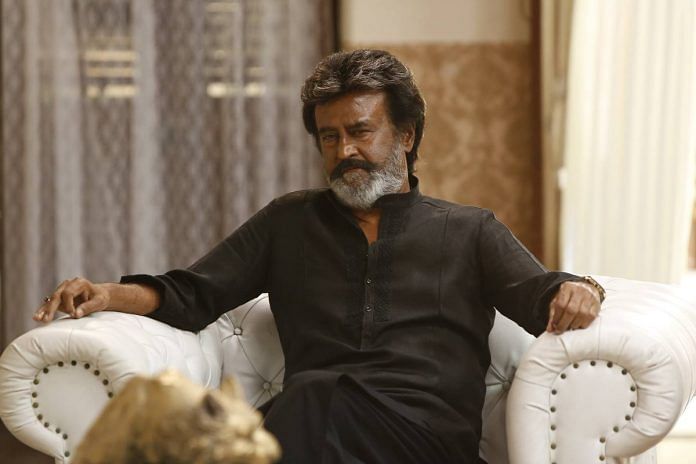The long shadow of the Gandhian thought is distinctly recognisable in Sujata, a film about overcoming prejudice.
There is a politically poignant scene in Bimal Roy’s 1959 classic Sujata, when the protagonist, a lower-caste orphan, contemplates suicide after she learns she was actually adopted by an upper-caste family. She is about to jump into the swollen river on the rainy night, but stops when she sees a statue of Mahatma Gandhi.
It’s a revealing moment for the director’s guiding philosophy and politics.
Nearly 60 years later, Tamil film Kaala by Dalit director Pa. Ranjith, has brought a defining moment of Dalit portrayal in India’s cinematic history. In the difference between the two movies lies the journey of India’s anti-caste politics – between 1959 and 2018.
Commentators across the board have hailed Ranjith for casting superstar Rajinikanth in a role that’s deeply political in its rendition.
Set in Mumbai’s Dharavi, Ranjith is presenting the story of Tamil migrants. His gaze is unusual because it comes from an insider’s perspective. Although made within the boundaries of a star-vehicle masala film, Ranjith bathes it all in blue and Ambedkar symbolism.
His protagonist, Kaala Karikalan, wants to reclaim the colour ‘black’, a signifier of caste. On the surface, the colour is also a marker of caste identity in Sujata. The protagonist is shown as dark-skinned. But colours – political and personal – have their own stories too.
In the early years of independent India, the nation-building project dominated the filmmakers’ oeuvre. Among them, Roy successfully tackled a number of progressive subjects in movies such as Bandini and Do Bigha Zameen.
Sujata was a landmark film at that time about caste, in which the filmmaker looked inward. Even as it revolves around an ‘untouchable’ woman, the story is not about her caste. It’s about the caste of her adoptive family. The transformation is not in her, but in the acceptance that the upper-caste family eventually extends to her – in keeping with the political philosophy of the first decade of the republic.
Handed over to an upper-caste engineer’s family in a moment of crisis, the orphan finds an unlikely home. In the early first hour, its best stretch, the film focuses on the reluctant affection and acceptance that the Chowdhurys afford the child they were initially inclined to throw away.
Upendranath, the young patriarch, comes from a family where his relatives won’t even stand close to a low-caste person. His wife, a woman of faith, and probably therefore prejudiced, treats her own kid Rama (of roughly the same age as Sujata) differently. She sings her lullabies. (A classic S.D. Burman, Nanhi Pari is sung even today.) One of the other visual tropes to portray the difference between the two children is the dull clothes the adopted child Sujata wears, which is in stark contrast to what Rama is seen in.
In probably its most powerful moment, Sujata becomes the film it wants to be. At the age of four, Sujata becomes a headache for her adoptive parents. She fiercely demands everything her sister receives and refuses to back down. The couple, despite their fondness for her, think of sending her to an orphanage.
But as she grows up and learns her standing in society, she develops a distinct reticence. Along the way, the family finds ways to uphold, and simultaneously break, the customs and norms of the society. The conflict heightens when she falls in love with a suitor her family has chosen for her sister. Despite their intended nobility, the sermons become increasingly patronising.
The long shadow of the Gandhian thought is distinctly recognisable because the film is actually about overcoming prejudice. It situates a Dalit character amid fundamentally decent, albeit, conservative Brahmins, and individualises her story.
While this doesn’t rob the film of its implicit empathy and a fundamentally conciliatory approach, one can’t help but wonder how Roy’s own caste may have played a role here. It’s the kind of criticism that one of Hollywood’s most significant book adaptations, To Kill A Mockingbird, faced too.
Ranjith’s Kaala is a different beast exactly because of this. Just like Nagraj Manjule’s 2016 breakout smash hit Sairat. These are stories told by people about themselves. It’s the assertion of self that separates these filmmakers from the ones who’ve come before. They’re all self-confessed Ambedkarites and that determines their gaze.
Despite their evident marginalisation in cinematic representation, Dalits have been portrayed in both stereotypical (Aakrosh, Raajneeti) and contextual (Masaan, Newton, Fandry) ways, especially in the last decade.
Cinema is as much art as it is an economic activity. As the economy grows, cinema will change too. What existed in 1959 may not necessarily hold in 2018. The burgeoning community of educated, urban Dalit middle class with purchasing power and social media leverage are also shaping the producer’s interest toward a different kind of portrayal.
There’s something else that stands out in Sujata and Kaala.
In one of Sujata’s early scenes, the young Dalit girl wants the same education that her sister is getting. When denied, she picks up a copy of Ramayana and claims it as ‘her book’. A scene like this, however, won’t pass muster in Ranjith’s Kaala, which turns the epic on its head by making Ravan the hero.




Appreciate it ” ThePrint ” the blindfolded still need a reason for even recognising some one’s effort to talk on it, when will they understand, how happy will they be to witness a khairlanji type massacre within their community. Will they greet them with arms wide open .. they may .. who knows .. they need a reason for review .. Craaazy.
What is the purpose of writing such reviews? Other casteist leaders and social justice peddlers have already written similar reviews on the movie on this website.